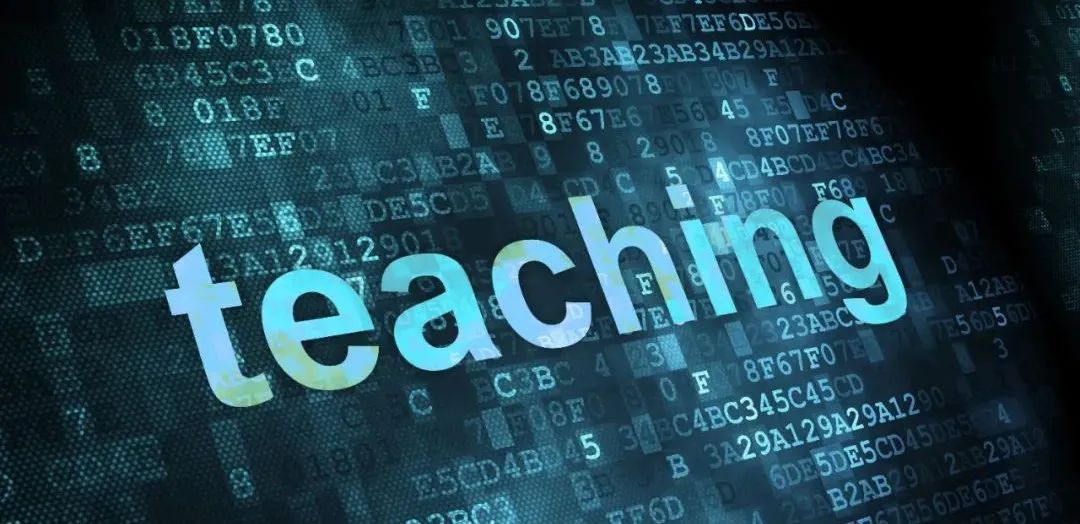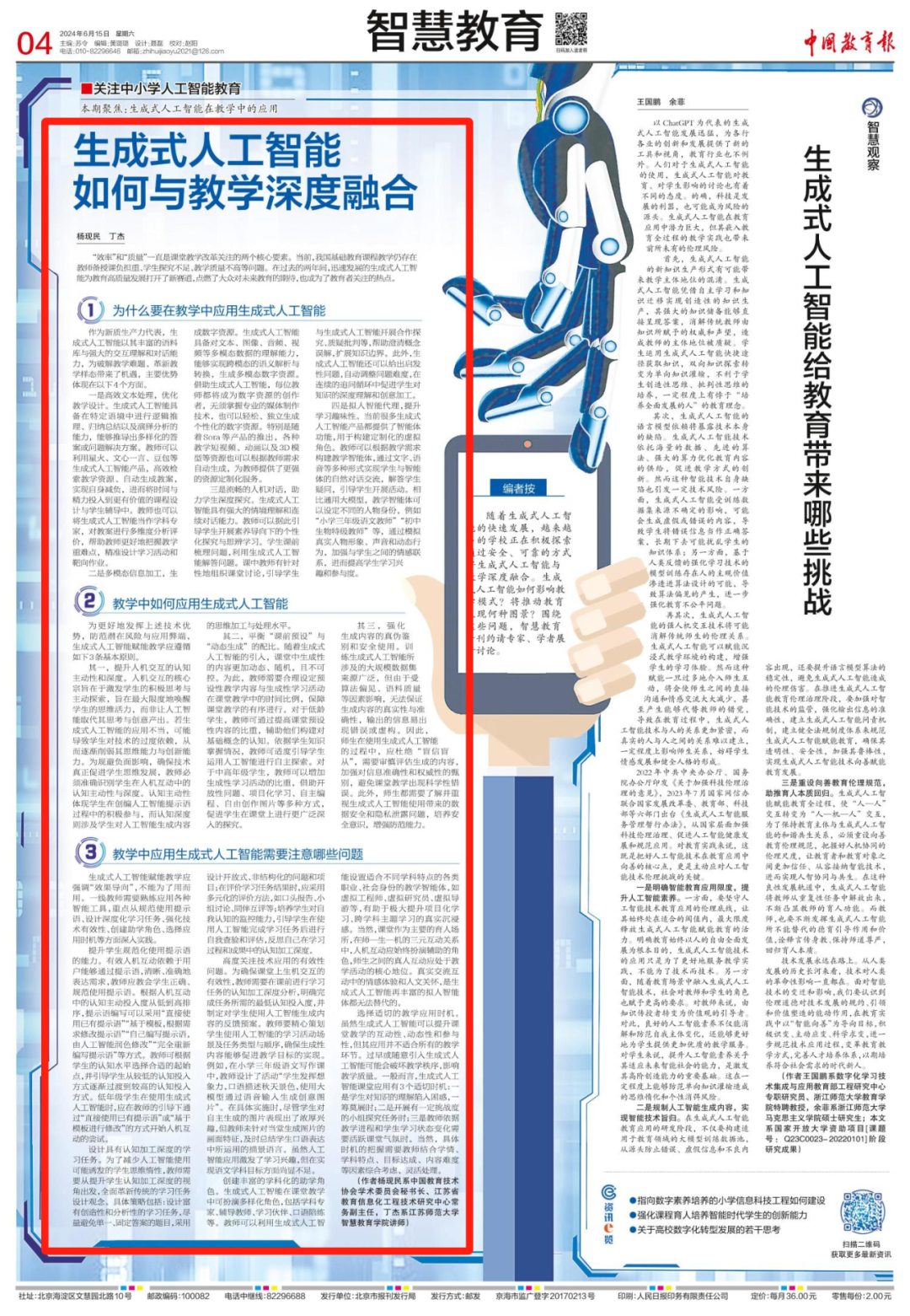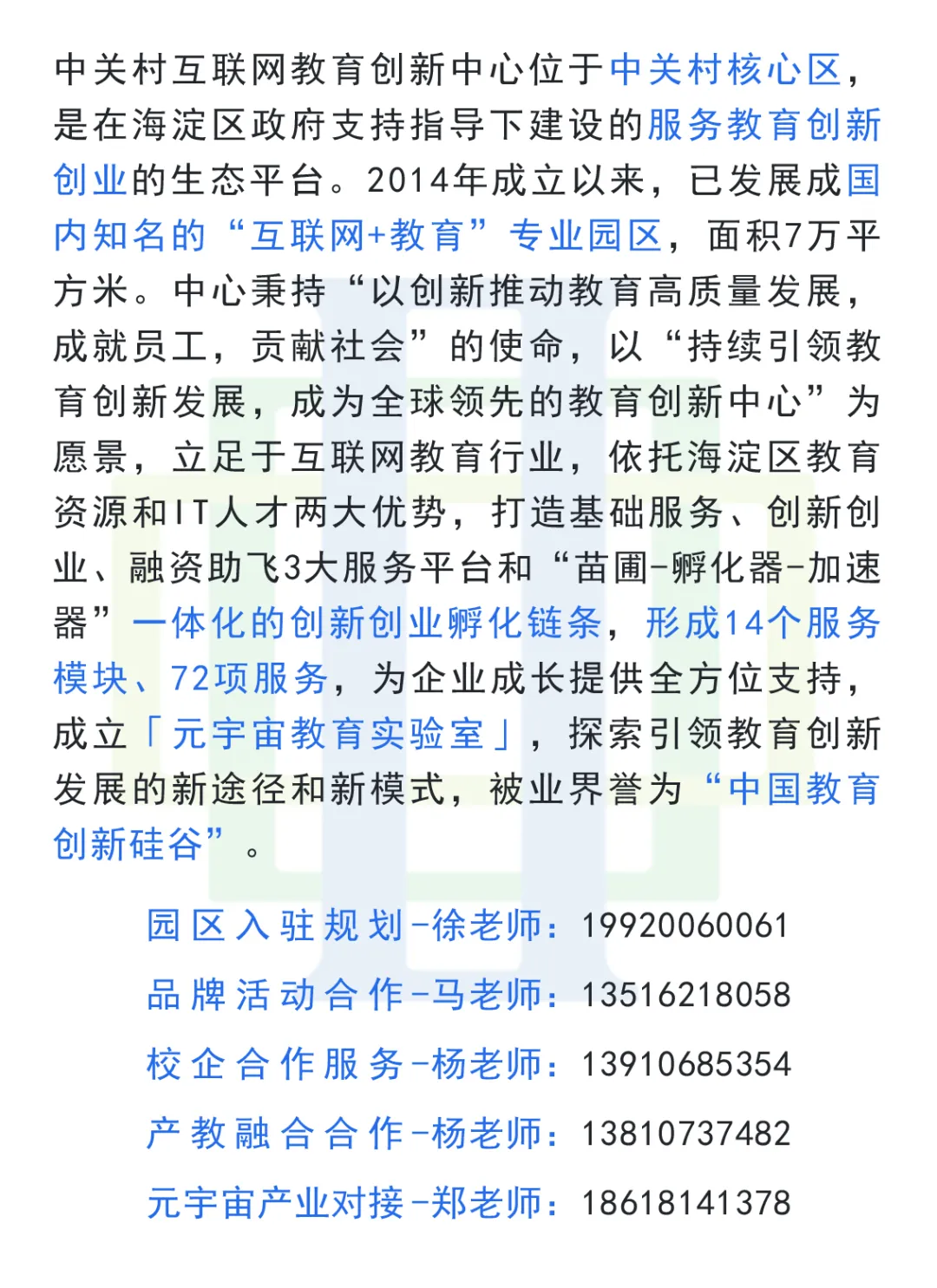“Efficiency” and “quality” have always been the two core elements of classroom teaching reform. Currently, there are still issues in basic education in China, such as heavy burdens on teachers in preparing and delivering lessons, insufficient student exploration, and low teaching quality. In the past two years, the rapidly developing generative artificial intelligence has opened up new avenues for high-quality educational development, igniting public expectations for the future of education, and has become a hot topic of concern for educators.

Why Apply Generative AI in Teaching
As a representative of new productive forces, generative artificial intelligence brings opportunities to solve teaching challenges and innovate teaching patterns with its rich corpus and strong interactive understanding and dialogue capabilities. Its main advantages are reflected in the following four aspects.First, efficient text processing optimizes teaching design.Generative artificial intelligence has the ability to perform logical reasoning, summarization, and deductive analysis in specific contexts, capable of deriving diverse answers or problem-solving solutions. Teachers can utilize generative AI products such as Spark, Wenxin Yiyan, and Doubao to efficiently search for teaching resources and automatically generate lesson plans, thereby reducing their workload and allowing them to invest more time and energy into more valuable course design and student guidance. Teachers can also use generative AI as subject experts to conduct multi-dimensional analysis and evaluation of lesson plans, helping them better grasp the key and difficult points of teaching, accurately design learning activities, and targeted assignments.Second, multi-modal information processing generates digital resources.Generative artificial intelligence possesses the ability to understand multi-modal data such as text, images, audio, and video, enabling cross-modal semantic analysis and transformation, generating multi-modal digital resources. With generative AI, every teacher can become a creator of digital resources without needing to master professional media production skills, easily and independently generating personalized digital resources. Especially with the launch of products like Sora, various teaching short videos, animations, and 3D models can also be automatically generated according to teachers’ needs, providing stronger resource customization services.Third, smooth human-computer dialogue aids deep student exploration.Generative artificial intelligence has powerful situational understanding and continuous dialogue capabilities. Based on this, teachers can guide students to carry out personalized inquiry and critical thinking learning oriented towards competencies. Students can clarify questions before class and use generative AI to answer those questions. During class, teachers can organize targeted discussions, guiding students to engage in collaborative inquiry and critical questioning with generative AI, helping to clarify conceptual misunderstandings and expand knowledge boundaries. In addition, generative AI can also provide thought-provoking questions and automatically adjust the difficulty of questions, promoting students’ deep understanding and creative processing of knowledge through continuous questioning cycles.Fourth, anthropomorphic intelligent agents enhance learning engagement.Currently, many generative AI products offer intelligent agent functions to build customized virtual roles. Teachers can create teaching intelligent agents based on teaching needs, allowing natural dialogue and interaction between students and agents through text, voice, and other forms, answering students’ questions and guiding them in activities. Compared to general large models, teaching intelligent agents can be assigned different character identities, such as “third-grade Chinese teacher” or “specialist biology teacher,” simulating real character images, voices, and dynamic behaviors to strengthen emotional connections with students, thereby increasing students’ interest and engagement in learning.
How to Apply Generative AI in Teaching
To better leverage the aforementioned technological advantages and mitigate potential risks and application drawbacks, the application of generative AI in teaching should adhere to the following three basic principles.First, enhance cognitive initiative and depth in human-computer interaction.The core purpose of human-computer interaction is to stimulate students’ active thinking and exploration, aiming to maximize the awakening of students’ cognitive vitality rather than allowing artificial intelligence to replace their thinking and creative output. If the application of generative AI is inappropriate, it may lead to students’ excessive dependence on technology, gradually weakening their thinking and innovation abilities. To avoid negative impacts and ensure that technology truly promotes students’ cognitive development, teachers must accurately identify students’ cognitive initiative and depth in human-computer interaction. Cognitive initiative reflects students’ active participation in crafting AI prompts, while cognitive depth involves the level of students’ cognitive processing and handling of AI-generated content.Second, balance the ratio of “pre-set content” and “dynamic generation.”With the introduction of generative AI, the content generated in the classroom becomes more dynamic, random, and uncontrollable. Therefore, teachers need to reasonably set the time ratio between pre-set teaching content and generative learning activities in classroom teaching to ensure orderly conduct of teaching. For younger students, teachers can increase the proportion of pre-set content to assist them in constructing an understanding of basic concepts. Depending on students’ knowledge mastery, teachers can moderately guide students to use AI for autonomous exploration. For middle and high-grade students, teachers can increase the proportion of generative learning activities, using open-ended questions, project-based learning, autonomous programming, and free creative image-making to promote broader and deeper exploration in the classroom.Third, strengthen the identification of the authenticity of generated content and ensure safe usage.The large-scale datasets used to train generative AI are sourced from various origins, but due to factors like algorithmic bias and corpus quality, the authenticity and accuracy of generated content cannot be guaranteed, and the output information may contain errors or fabrications. Therefore, both teachers and students should avoid “blind faith and blind following” in the process of using generative AI, carefully evaluating the generated content and enhancing the verification of information accuracy and authority to avoid scientific errors in classroom teaching. Additionally, both teachers and students need to understand and emphasize the data security and privacy leakage issues brought about by the use of generative AI, cultivating safety awareness and enhancing preventive capabilities.What Issues to Pay Attention to When Applying Generative AI in Teaching
The application of generative AI in teaching should emphasize “effectiveness orientation,” and not just use it for the sake of using it.Frontline teachers need to proficiently apply various intelligent tools, focusing on practical aspects such as standardizing the use of prompts, designing in-depth learning tasks, strengthening technical effectiveness, creating supportive roles, and choosing appropriate application timing.
Enhance students’ ability to use prompts correctly.Effective human-computer interaction relies on users being able to express their needs clearly and accurately through prompts. Teachers should teach students how to use prompts correctly and规范化. Based on the cognitive initiative input in human-computer interaction, prompts can be sorted from low to high engagement levels, using methods such as “directly using existing prompts,” “modifying prompts based on templates according to needs,” “self-writing prompts and having AI polish them,” and “completely rewriting prompts.” Teachers can choose suitable starting points based on students’ cognitive levels and guide them to gradually transition from lower to higher cognitive involvement methods. Younger students should begin their attempts at human-computer interaction under the guidance of teachers by using either “existing prompts” or “template modifications.”
Design learning tasks with cognitive processing depth.To reduce the potential cognitive inertia induced by AI use, teachers need to comprehensively innovate traditional learning task design concepts from the perspective of enhancing students’ cognitive processing depth. Specific strategies include: designing creative and analytical learning tasks, avoiding single, fixed-answer questions, and adopting open-ended, unstructured questions and projects; using diverse evaluation methods such as oral presentations, group discussions, and peer evaluations when assessing learning task results; and cultivating students’ self-monitoring abilities, guiding them to self-check and evaluate their cognitive processing depth after using AI to complete learning tasks.
Pay close attention to the effectiveness of technology application.To ensure the effectiveness of human-computer interactions in the classroom, teachers need to analyze the cognitive processing depth required for learning tasks before class, clarify the minimum cognitive input needed to complete tasks, and develop feedback plans for students using AI-generated content. Teachers should carefully plan the learning activity scenarios and task types and sequences for students using AI, ensuring that the generated content promotes the achievement of teaching goals. For example, in a third-grade Chinese writing class, a teacher designed an activity where “students use their imagination to verbally describe autumn scenery and use a large model to generate creative images through voice input.” In practice, although students showed great interest in the images they generated independently, the teacher did not timely summarize the descriptive language used in students’ verbal expressions regarding the generated images. Although the application of AI stimulated learning interest, it fell short in achieving the goals of the Chinese language subject.
Create rich subject-specific supportive roles.Generative AI can play diverse roles in classroom teaching, including subject experts, tutoring teachers, learning partners, and speaking practice companions. Teachers can utilize generative AI to set up various teaching intelligent agents suitable for different subject characteristics, such as virtual engineers, virtual researchers, and virtual tour guides, which can greatly enhance the immersive experience of project-based learning and interdisciplinary thematic learning. Of course, as the primary place for education, in the triadic interaction relationship of teacher-student-machine, human-computer interaction should always play a supportive role, with real human interaction between teachers and students at the core of teaching activities. The emotional experiences and human care in authentic communication and interaction cannot be replaced by even the most sophisticated anthropomorphic intelligent agents.
Select appropriate timing for teaching applications.Although generative AI can enhance the interactivity, dynamism, and participation of classroom teaching, its application is not suitable for all teaching segments. Introducing generative AI too early or casually may disrupt teaching order and affect teaching quality. Generally speaking, there are three appropriate timings for applying generative AI in the classroom: first, when students are confused about their understanding of knowledge and at a loss; second, when conducting small group inquiry tasks with a certain level of challenge; and third, when teachers need to enliven the classroom atmosphere based on changes in teaching progress and students’ learning status. Of course, the specific timing needs to be flexibly handled by teachers, considering factors such as student conditions, subject characteristics, goal achievement, and content difficulty.


Follow the Official Video AccountGet More Educational Information


Source丨”China Education News”, Original Title: “How Generative AI Integrates Deeply with Teaching“ Author丨Yang Xianmin (Secretary-General of the Academic Committee of the China Educational Technology Association, Executive Deputy Director of the Jiangsu Provincial Educational Informatization Engineering Technology Research Center) Ding Jie (Lecturer at the School of Smart Education, Jiangsu Normal University) Edited by丨YeZi Reviewed by丨Xi Bei Copyright StatementThis article is a re-edited piece from the WeChat public account “Zhongguancun Internet Education Innovation Center (ID: zgc-mtb)”. The images added after editing are sourced from the internet. This account does not take responsibility for the views expressed in the article, and it is for sharing purposes only, providing no express or implied guarantees regarding the accuracy, reliability, or completeness of its content. The copyright of the article and images belongs to the original authors. If the shared content infringes your copyright, please contact us in a timely manner, and we will quickly review and handle it.
 Share
Share Save
Save View
View Like
Like
